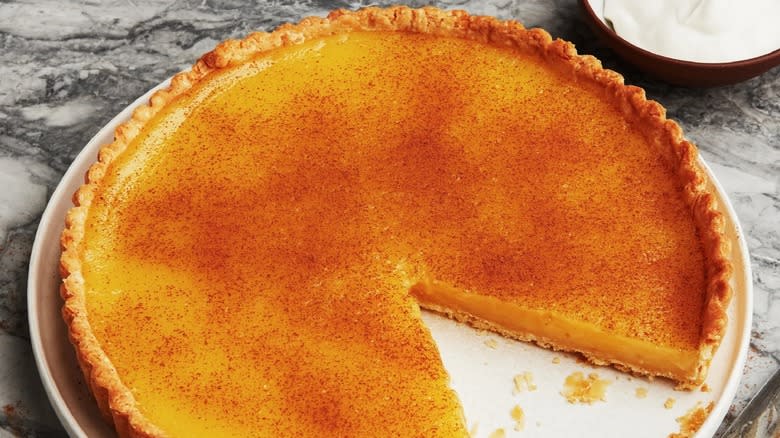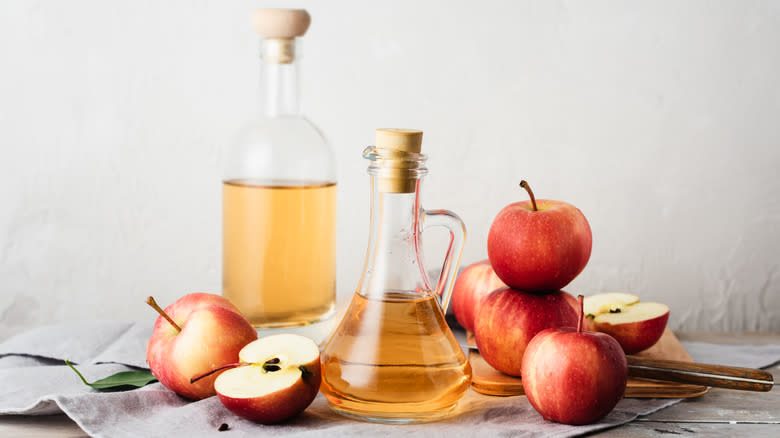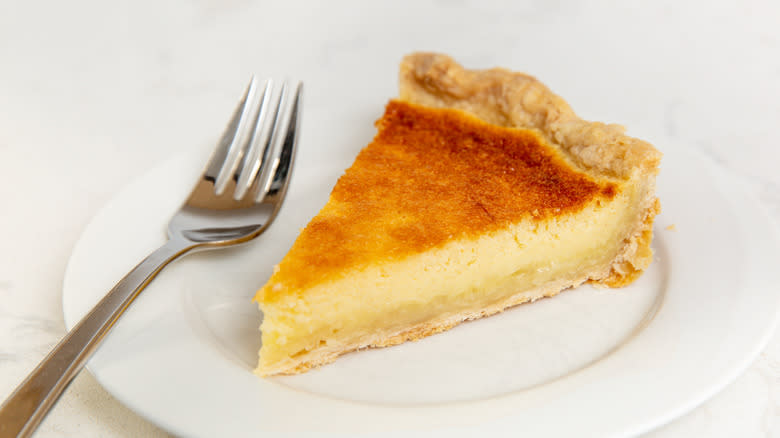What Exactly Is Vinegar Pie And How Does It Taste?

Vinegar and pie may seem like they'd go together about as well as chocolate and fish, but the combo is actually a surprisingly inventive way to make a pie without a ton of ingredients. Vinegar is a magical thing: It's versatile, pretty inexpensive to keep on hand, and just so happens to be a key ingredient in this uniquely delicious dessert. You may think vinegar pie would be sharp and sour, but you'd be wrong. It's actually akin to lemon meringue pie, or even the Southern delicacy buttermilk pie, thanks to the light tartness provided by the vinegar.
This pie utilizes what is available when there isn't a whole lot in one's pantry. Not unlike Depression-era recipes like water pie or Sprite pie, vinegar pie doesn't have that many moving parts, but the result is something custardy and rich, and even fruity, depending on what you have lying around the house.
Read more: Cake Hacks Every Baker Will Wish They Knew Sooner
History Of Vinegar Pie

The first publication of a vinegar pie recipe can be traced back to Colorado at the start of the 20th century. It was published in the Leadville Herald Tribune in May of 1905, though the recipe probably dates back as far as the mid-19th century. It appears to be American in origin, and is most likely the result of desperate times meeting desperate measures and resulting in a tasty revelation. As the original recipe suggests, the pie filling is meant to become custard-like in texture, and relies on flour, eggs, and butter for the body of the filling.
There are so many types of vinegar, so which is best for pie? Again, it really depends on what you've got on hand. It was likely the case that people in Colorado at the time this recipe was published were using apple cider vinegar, as it was common practice to save fruit scraps and make vinegar with them. White vinegar can be used if that's what you have in your pantry, but historically, white vinegar is a byproduct of alcohol production, so it was likely unavailable in a typical household from this particular time period.
How To Serve Vinegar Pie

The vinegar imparts much of the pie's flavor, so if you want a fruitier pie, apple cider (or any fruit-based vinegar) would be ideal. Historically, many folks would use the vinegar leftover from canned and jarred fruits because of its syrupy sweetness. However, if you're making this pie and have fresh fruit to add, the result will be more flavorful than using fruit vinegar alone. You can also use fruit juice. For instance, vinegar can be used in conjunction with lemon juice to create more tartness and an overall fruitier pie. The acidity from both the vinegar and lemon juice does mellow in the baking process and helps boost the fruit flavors, while providing a little tanginess that prevents a cloying, overly-sweet pie.
This is a high-volume liquid pie, so it can be tricky to determine doneness by sight alone. You're looking for a thick but slightly jiggly center with a golden brown top, but if you're still unsure if the pie is done, you can always use a kitchen thermometer. When your pie's internal temperature is at 160 degrees Fahrenheit, you'll know it's done. Be sure to let your pie come to room temperature before cutting into it, as it needs time to fully set. This pie can be served chilled, or if you're feeling extra ambitious, with a dollop of whipped cream.
Read the original article on Daily Meal.

